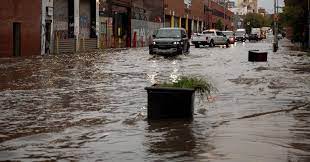
New York City, a bustling metropolis known for its iconic skyline and vibrant streets, has once again found itself grappling with the devastating aftermath of heavy rainfall and severe flooding. The recent deluge has pushed the city to declare a state of emergency, leaving its residents and authorities struggling to cope. But this isn’t a one-time occurrence; it’s a recurring nightmare that seems poised to worsen in the face of climate change.
The heart of the issue lies in the city’s drainage system, a critical component of urban infrastructure tasked with managing rainwater and preventing flooding. New York City’s drainage system is designed to handle a maximum rainfall rate of 1.75 inches per hour, a capacity that, in many instances, has proven insufficient in the face of increasingly intense and frequent rain events.
The recent flooding, which inundated streets, subways, and even airports, was triggered by a rainfall rate exceeding the system’s threshold. As New York City experienced over 2 inches of rain within a short period, the drainage system struggled to keep up, leading to widespread inundation.
Rohit Aggarwala, the commissioner of the New York City Department of Environmental Protection, identified climate change as the driving force behind the changing weather patterns that have brought about these extreme rainfall events. He pointed out the stark reality that the climate is evolving at a pace far outstripping the city’s infrastructure’s ability to adapt.
One particular challenge lies in the configuration of the city’s drainage system, where stormwater and sewage share the same pipes in more than half of the city. When these combined systems reach their limits, untreated wastewater spills into local waterways and often finds its way into the basements of homes and businesses.
Scientists and climate experts, including Michael Mann from the University of Pennsylvania, highlight that these flooding events are not just a “new normal” but rather a “new abnormal.” Climate change’s impact extends beyond warming the planet and increasing moisture in the atmosphere, which can lead to heavy rainfall and flooding. It is also altering the behavior of the jet stream, contributing to stalled weather systems that linger for days or weeks, exacerbating the risk of flooding.
As New York City grapples with the immediate aftermath of this latest flooding episode, it must also confront the sobering reality that addressing the growing flood threat requires not only short-term solutions but also a long-term commitment to climate resilience and infrastructure adaptation in the face of a changing climate.
Sources By Agencies


